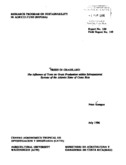| dc.contributor.author | Kampen, P. | |
| dc.contributor.other | CATIE - Centro Agronómico Tropical de Investigación y Enseñanza | |
| dc.date.accessioned | 2021-05-19T19:47:34Z | |
| dc.date.available | 2021-05-19T19:47:34Z | |
| dc.date.issued | 1996-07 | |
| dc.identifier.uri | https://repositorio.catie.ac.cr/handle/11554/10826 | |
| dc.description | 64 páginas, 11 figuras, 5 tablas, 43 ref. También como serie: Field Report - Atlantic Zone Programme (CATIE); no. 149 | es_ES |
| dc.description.abstract | This study was carried out in Río Jiménez, a sub-region in the northern part of the Atlantic Zone of Costa Rica. Silvopastoral systems are widely practised land use systems in the Atlantic Zone of Costa Rica and are mostly established after forest clearing. Three soil use classes are distinguished, silvopasture mostly occur on infertile soils with good drainage. The research is started with a literature review on the theoretical background of the interactions between trees and pasture in silvopastoral systems. After this, field research was done in the Río Jiménez area in the Atlantic Zone. The field research was restricted to two tree species, Pentaclethra macroloba (Gavilán) and Cordia alliodora (Laurel) and two pasture types, Pasto Natural (a mixture of local grass species) and Ischaemum ciliare (Ratana). A silvopastoral system, an agroforestry system, is comprised of three components, i.e. trees, pasture and cattle. The different components influence each other. A relational diagram is used to analyze the production side of the system. The different relations between the components are derived from system analysis and elaborated further using other research. Within the tree-grass relation the available amount of light under trees is seen as the main factor to determine grass production under trees. Grass production can be higher compared to the open field production, caused by an improvement of the understorey micro climate. When light saturation is not reached, increased light intensities result in an increased grass production until other factors, like temperature and water stress become more limiting to grass production. | es_ES |
| dc.language.iso | en | es_ES |
| dc.publisher | CATIE, Turrialba (Costa Rica). Atlantic Zone Programme. Agricultural University Wageningen, Wageningen (Países Bajos). Ministerio de Agricultura y Ganadería, San José (Costa Rica). | es_ES |
| dc.relation.ispartof | Report - Atlantic Zone Programme (CATIE-WAU-MAG); number 104 | es_ES |
| dc.rights | info:eu-repo/semantics/openAccess | es_ES |
| dc.subject | AGROFORESTERIA | es_ES |
| dc.subject | PASTIZALES | es_ES |
| dc.subject | SISTEMAS SILVOPASCÍCOLAS | es_ES |
| dc.subject | UTILIZACIÓN DE LA TIERRA | es_ES |
| dc.subject | PRODUCCIÓN VEGETAL | es_ES |
| dc.subject | COSTA RICA | es_ES |
| dc.subject.other | Sede Central | |
| dc.title | Trees in grassland: the influence of trees on grass production within sylvopastoral systems of the Atlantic Zone of Costa Rica | es_ES |
| dc.type | Reporte | es_ES |


